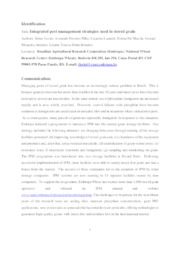Integrated pest management strategies used in stored grain.
Integrated pest management strategies used in stored grain.
Author(s): LORINI, I.; FERREIRA FILHO, A.; LUNARDI, L.; MARCHI, F. de; ANTUNES, J. M.; BONATTO, L. T. D.
Summary: Managing pests of stored grain has become an increasingly serious problem in Brazil. This is because grain production has more than doubled in the last 10 years and insect pests have become resistant to protectant insecticides. In the same period, use of phosphine fumigation has increased rapidly and is now widely practised. However, control failures with phosphine have become common as fumigations are undertaken in unsealed silos and in situations where sanitation is poor. As a consequence, many parcels of grain are repeatedly fumigated. In response to this situation, Embrapa initiated a programme to introduce IPM into the central grain storage facilities. Our strategy included the following elements: (a) changing behaviour through training of the storage facilities personnel; (b) improving knowledge of stored grain unit; (c) cleanliness of the equipment and premises and, after that, spray residual insecticide; (d) identification of grain-stored pests; (e) resistance tests; (f) insecticide treatment and fumigation; (g) sampling and monitoring the grain. The IPM programme was introduced into two storage facilities in Paraná State. Following successful implementation of IPM, these facilities were able to supply insect-free grain and had a bonus from the market. The success of these companies led to the adoption of IPM by other storage companies. IPM systems are now running in 13 separate facilities owned by nine companies. To support the programme, Embrapa Wheat has trained more than 1,000 stored grain operators and released an IPM manual and website http://www.cnpt.embrapa.br/pesquisa/entomologia/mip. The challenges to be pursue for the next fifteen years of the research team are sealing silos, measure phosphine concentrations, pure PH3 applications, new protectants as spinosad (the bacterial derivate pesticide), offering technologies to guarantee high quality grains with insect free and residues free in the international market.
Publication year: 2012
Types of publication: Abstract in annals or event proceedings
Unit: Embrapa Soybean
Keywords: Grãos
Observation
Some of Embrapa's publications are published as ePub files. To read them, use or download one of the following free software options to your computer or mobile device. Android: Google Play Books; IOS: iBooks; Windows and Linux: Calibre.
Access other publications
Access the Agricultural Research Database (BDPA) to consult Embrapa's full library collection and records.
Visit Embrapa Bookstore to purchase books and other publications sold by Embrapa.

